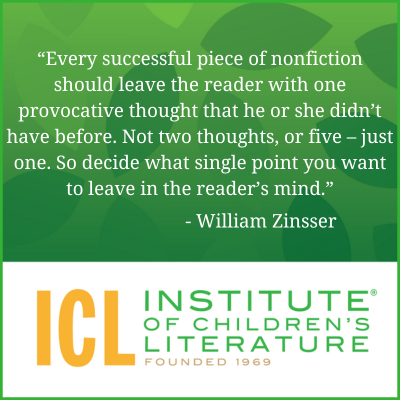
5 Ways Writers Can Prep for 2025 Goal Setting
Before we roll on to the new writing year, let’s harness our optimism for the blank slate before us and prepare for our 2025 Goal Setting just for writers.

Nonfiction offers a lot to young readers. It’s engaging. It opens doors into places, people, and creatures that might be outside a child’s immediate experience. It makes kids think and sometimes gets them up and doing something. In all that nonfiction does, it’s important for each writer to decide the core thing the piece they have written accomplishes. What do you want readers to take away from the words you’ve written?

Traditional nonfiction also requires meticulous organization to work and can introduce young readers to things like topic sentences and supporting ideas. It can demonstrate how to create smooth transitions between subtopics. All these things introduce students to writing.
Reading good solid nonfiction is a great way to teach it. Even as the child dives into yet another dinosaur book, he’s learning about how all nonfiction works and how to organize information. Readers also meet things like indexes and bibliographies in general nonfiction as well, tools they will use often as they write reports and do research throughout their school career.
One huge takeaway that many modern nonfiction books offer is humor. Humor allows readers to consider complex ideas in a non-threatening way. Humor keeps readers reading when the vocabulary or ideas become more complex. Writers who take a light touch often find they become popular with publishers.

Inspiration is more than a feeling. A nonfiction book may inspire a reader to action. A book about climate change, for example, is potentially scary, as the results of climate change are and will continue to be serious.
But most nonfiction for young readers also gives the reader a plan and things to do to help alleviate the problem. A huge problem like climate change cannot be solved by one child making changes but can inspire a child to join a larger company of people who are doing things to facilitate change. In this way, inspiration builds hope but also urges action in most young people’s nonfiction.

Also, these books are a special help for young people who are active learners, the ones who learn best when they can work with manipulatives, try things out, or create something new. These types of learners may feel left out in much of the learning in a classroom setting, but active nonfiction offers these children a connection to learning in a new way.
The bigger the takeaway value, the more it does for the reader, the longer the nonfiction will be remembered, and the more change results. As you’re writing nonfiction, no matter what form it takes or what length, give thought to the takeaway value the piece brings to the reader. What does this piece do for the child who reads it?
Knowing the takeaway value not only helps you strengthen connections to the reader, it also gives you a way to capture the editor’s heart when you’re offering the book manuscript or magazine article, so always mention your big idea or takeaway value in your cover and query letters. It makes a difference. And it may help you make a sale with the editor or agent who is always looking for a great big idea.
With over 100 books in publication, Jan Fields writes both chapter books for children and mystery novels for adults. She’s also known for a variety of experiences teaching writing, from one session SCBWI events to lengthier Highlights Foundation workshops to these blog posts for the Institute of Children’s Literature. As a former ICL instructor, Jan enjoys equipping writers for success in whatever way she can.

Before we roll on to the new writing year, let’s harness our optimism for the blank slate before us and prepare for our 2025 Goal Setting just for writers.

Writers can be thin-skinned when it comes to getting feedback on their work. Let’s look at 4 ways to positively deal with constructive criticism!

Rejection is part of the territory when it comes to being a writer. Today we offer reflection for writers to help redirect your efforts after a rejection.
1000 N. West Street #1200, Wilmington, DE 19801
© 2024 Direct Learning Systems, Inc. All rights reserved.
1000 N. West Street #1200, Wilmington, DE 19801
© 2024 Direct Learning Systems, Inc. All rights reserved.
1000 N. West Street #1200, Wilmington, DE 19801
© 2024 Direct Learning Systems, Inc. All rights reserved.
1000 N. West Street #1200, Wilmington, DE 19801
© 2024 Direct Learning Systems, Inc. All rights reserved.

1000 N. West Street #1200, Wilmington, DE 19801
© 2025 Direct Learning Systems, Inc. All rights reserved.

1000 N. West Street #1200, Wilmington, DE 19801
©2025 Direct Learning Systems, Inc. All rights reserved. Privacy Policy.
6 Comments